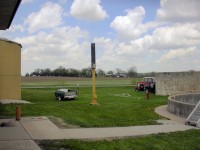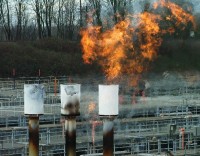By Anthony Watts, Watts Up With That
Sometimes, words fail me in describing the absolute disregard of the placement of NOAA official climate monitoring sites. For example, this one in Clarinda, Iowa submitted by surfacestations volunteer Eric Gamberg:

The MMTS temperature sensor is the short pole next to the half pickup truck.
For those of you that don’t know, this station is located at the wastewater treatment plant there. I’ve written many times about the placement of stations at WWTP’s being a bad idea due to the localized heat bubble that is created due to all the effluent coming though. The effect is especially noticeable in winter. Often you’ll see steam/water vapor in the air around these sites in winter, and more than one COOP observer has told our volunteers that snow sometimes does not stick to the ground at WWTP’s.
The larger pole appears to be a gas burnoff torch for excess methane. I can’t say how often it is activated (note the automatic ignitor circuit on the pole) but I can tell you that putting an official NOAA climate thermometer within a few feet of such a device is one of the worst examples of thoughtless station placement on the part of NOAA I’ve ever seen. Here is an example of a methane burn-off device at another WWTP.

We’ll probably never know what the true temperature is in Clarinda because untangling a measurements mess like this is next to impossible. How many days was Tmin and/or Tmax affected at this location by gas burnoff and to what magnitude? We shouldn’t have to ask these questions. And, adding insult to stupidity, the GISTEMP Homogenization adjustment makes the trend go positive, especially in recent years. (see automated animation of the before and after here).
Dr. Hansen and Mr. Karl - welcome, feast your eyes on the source of your data. You might want to think about changing this description on the NCDC website for USHCN: “The United States Historical Climatology Network (USHCN) is a high quality, moderate-sized data set of daily and monthly records of basic meteorological variables from over 1000 observing stations across the 48 contiguous United States.”
I suggest to NCDC that “high quality” doesn’t really apply in the description anymore. See full post and comments here.




